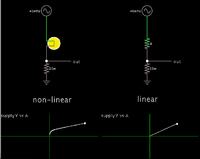danny davis
Banned

What are phase lock circuits used for?
I know the circuit locks phase IN phase together , but why would you need or want that?
Without a phase lock circuit, it's called free running
Are Phase Lock Circuits used just to lock the input and output together?
To test if a phase lock circuit is working, you put oscilloscope channel#1 on the input and oscilloscope channel#2 on the output on a unit
The problem here for me is that I can only use the Probes Ground on Channel#1 only
Oscilloscope channel#2 probe doesn't have a ground, so the sine waveform is noisy and moves back and forth very fast some techs call it oscillation or noise
I set the time base on the oscilloscope so that I can see the phase shift so they are so very close together, that they are in phase
The problem is that the channel#2 waveform is so noise and moving I can't take a measurement
I can't use the probe ground on channel#2 because my manager says that it will fry the oscilloscope because there is a DC offset or a potential difference voltage from earth ground, and it will cause a SHORT CIRCUIT
If a circuit has DC offset on the ground or a potential difference from earth ground, the oscilloscopes ground will SHORT CIRCUIT the DC offset or potential difference
My manager told me that I can use a DVM meter and measure the input AC HOT line Black wire with the outputs AC HOT line Black wire, It measured 7 volts AC going from input HOT to output HOT. He said this is the phase angles voltage of the inputs sinewave and the outputs sinewave. Next I measured using the DVM meter to the Neutrals White wire from the input to the Neutrals White wire at the output of the unit, it measured 1.4 volts AC. He said this is a phase angle voltage, the phase angle is the inputs waveform and the outputs waveform, the phase shift between the input and output
I have seen techs use an Ez jumper wire to extend the oscilloscopes probe at the probes tip rather than using it on the ground clip. When you use an Ez Hook jumper wire on the ground clip, it picks up to much noise. But when you use an Ez hook jumper wire on the probes tip and use the Ez hook to measure test points, it doesn't have noise on the signal.
The Probes ground clip is so short it's so hard to make measurements, So you use an Ez hook on the probes lead instead of extending the probes ground clip
I'm just confused as why they just don't make a oscilloscope probe that has a longer probe tip
I know the circuit locks phase IN phase together , but why would you need or want that?
Without a phase lock circuit, it's called free running
Are Phase Lock Circuits used just to lock the input and output together?
To test if a phase lock circuit is working, you put oscilloscope channel#1 on the input and oscilloscope channel#2 on the output on a unit
The problem here for me is that I can only use the Probes Ground on Channel#1 only
Oscilloscope channel#2 probe doesn't have a ground, so the sine waveform is noisy and moves back and forth very fast some techs call it oscillation or noise
I set the time base on the oscilloscope so that I can see the phase shift so they are so very close together, that they are in phase
The problem is that the channel#2 waveform is so noise and moving I can't take a measurement
I can't use the probe ground on channel#2 because my manager says that it will fry the oscilloscope because there is a DC offset or a potential difference voltage from earth ground, and it will cause a SHORT CIRCUIT
If a circuit has DC offset on the ground or a potential difference from earth ground, the oscilloscopes ground will SHORT CIRCUIT the DC offset or potential difference
My manager told me that I can use a DVM meter and measure the input AC HOT line Black wire with the outputs AC HOT line Black wire, It measured 7 volts AC going from input HOT to output HOT. He said this is the phase angles voltage of the inputs sinewave and the outputs sinewave. Next I measured using the DVM meter to the Neutrals White wire from the input to the Neutrals White wire at the output of the unit, it measured 1.4 volts AC. He said this is a phase angle voltage, the phase angle is the inputs waveform and the outputs waveform, the phase shift between the input and output
I have seen techs use an Ez jumper wire to extend the oscilloscopes probe at the probes tip rather than using it on the ground clip. When you use an Ez Hook jumper wire on the ground clip, it picks up to much noise. But when you use an Ez hook jumper wire on the probes tip and use the Ez hook to measure test points, it doesn't have noise on the signal.
The Probes ground clip is so short it's so hard to make measurements, So you use an Ez hook on the probes lead instead of extending the probes ground clip
I'm just confused as why they just don't make a oscilloscope probe that has a longer probe tip







